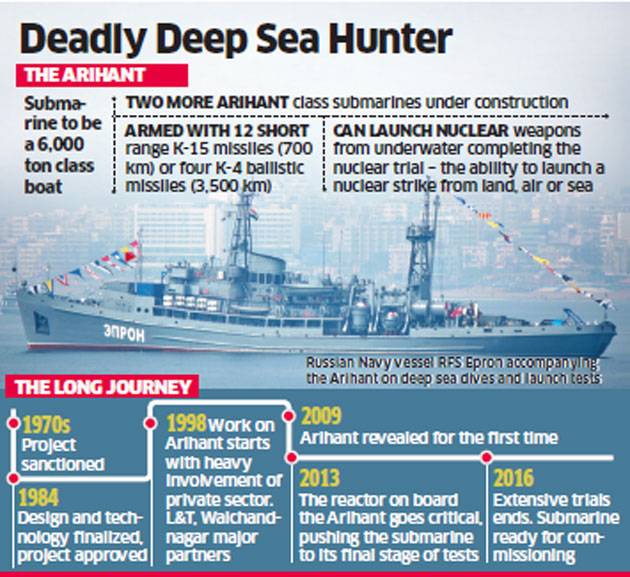What is the issue?
- India’s first nuclear propelled submarine, INS Arihant, was recently announced to be operationally ready.
- With Pakistan’s India-aimed nuclear doctrine and China’s ambiguity, India needs to boost its nuclear arsenal.
What is India's nuclear vision?
- India earlier had the capabilities to launch nuclear weapons from the air, mounted largely on its Mirage 2000 and Jaguar Aircraft.
- The similar land based missile range from Agni 1 missile (range of 700-900 km) to Agni 5 Missiles (range of 5500 km).
- India's aim has been to develop a “credible nuclear deterrent” with capabilities to deliver nuclear weapons from multiple locations on land, air and sea.
- The targets are all strategic areas and centres in India's two nuclear-armed neighbours - China and Pakistan.
Why is INS Arihant significant?
- The Arihant provides India with a capability to hit either neighbour (China, Pak) from 300 meters under the sea.
- The sea-based missiles envisaged for this purpose are
- the Sagarika with a range of 750 km
- the K-4 with a range of 3500 km
- While land-based missile sites can be attacked and destroyed, a submarine-based deterrent is virtually secure against a missile attack.
- India is the only country having a sea-based nuclear deterrent, which is not a Permanent Member of the UN Security Council.
- India will soon operationalise a second nuclear submarine the “Arighat”.
- It is expected to have a fleet of four such submarines by 2022.
- According to US Federation of Nuclear Scientists, India currently possesses 130-140 nuclear weapons, Pakistan 140-150 and China 280.
- While India tested its first nuclear weapons in 1998, Pakistan’s first weapons test was in 1990, on Chinese soil.

What are the countries' nuclear principles?
- India - India’s nuclear doctrine stated that its nuclear weapons would only be used in retaliation.
- It could be against a major attack on Indian territory or on Indian forces anywhere, in which nuclear weapons are used.
- India also retains the right to use nuclear weapons in the event of major attacks in which chemical or biological weapons are used.
- Pakistan - Pakistan, on the other hand, does not have a formal nuclear doctrine.
- However as stated before by its officials, Pakistan’s nuclear weapons are “aimed solely at India”.
- Accordingly, Pakistan would use nuclear weapons if India conquers a large part of its territory, or destroys a large part of its land and air forces.
- The possibility of nuclear weapons use if India tries to “economically strangle” Pakistan, or pushes it to political destabilisation also exists.
- Pakistan’s statements in recent years have, however, indicated that it would not be averse to using tactical nuclear weapons in a conventional conflict with India.
- China - China, like India, had proclaimed that it would not be the first to use nuclear weapons.
- But China has maintained a measure of ambiguity on whether its “no first use” pledge will be applicable to India.
- China's deliberate maintenance of this ambiguity is seen as a signal of its support to Pakistan on any of its nuclear exchange with India.
- Chinese ambiguity only adds to India’s determination to strengthen its “Triad” of land, air and sea-based nuclear weapons.
What is China's role in Pakistan?
- It is said that the Chinese did a massive training of Pakistani scientists.
- Without China’s help, Pakistan’s bomb would not exist.
- China has also provided Pakistan the designs of its nuclear weapons.
- It upgraded Pakistan's “inverters” for producing enriched uranium in Kahuta.
- It provided it with Plutonium reactors and separation facilities, for building tactical nuclear weapons.
- Pakistan’s ballistic and Cruise Missiles are also replicas of Chinese missiles.
What are the bureaucratic shortcomings in India?
- India has a well-organised nuclear command structure headed by the Prime Minister and Cabinet Committee on Security.
- However, India needs to address serious issues on the archaic structure of the Ministry of Defence.
- E.g. the key military figure in the Nuclear Command structure, the Chairman of the Joint Chiefs of Staff Committee, generally holds office for less than a year
- This is hardly the time adequate to become fully familiar with the complexities of India's Strategic Nuclear Command.
- There have been repeated proposals for appointment of a full time “Chief or Defence Staff”, or “Chairman Chiefs of Staff Committee”.
- S/he will hold charge of the Nuclear “Strategic Forces Command” and report to the political authority.
- But the proposals have gathered dust for years in the offices of the generalist bureaucracy of the Defence Ministry.
- Recommendations for such change even from the Parliament Standing Committee of Defence lie unimplemented.
- The present set up of the Defence Ministry thus needs to be drastically reorganised.
Source: BusinessLine
